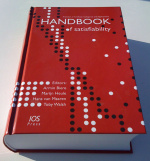Handbook of Satisfiability
Chapter 13: Fixed-Parameter Tractability
Chapter 13, pp. 425-454.
Handbook edited by Armin Biere, Marien Heule, Hans van Maaren, and Toby Walsh.
IOS Press, 2009. 980 pages. ISBN: 978-1-58603-929-5
Handbook's homepage with ordering information from publisher

Abstract
Parameterized complexity is a new theoretical framework that considers, in addition to the overall input size, the effects on computational complexity of a secondary measurement, the parameter. This two-dimensional viewpoint allows a fine-grained complexity analysis that takes structural properties of problem instances into account. The central notion is "fixed-parameter tractability" which refers to solvability in polynomial time for each fixed value of the parameter such that the order of the polynomial time bound is independent of the parameter. This chapter presents main concepts and recent results on the parameterized complexity of the satisfiability problem and it outlines fundamental algorithmic ideas that arise in this context. Among the parameters considered are the size of backdoor sets with respect to various tractable base classes and the treewidth of graph representations of satisfiability instances.Back Cover Text
Satisfiability (SAT) related topics have attracted researchers from various disciplines: logic, applied areas such as planning, scheduling, operations research and combinatorial optimization, but also theoretical issues on the theme of complexity and much more, they all are connected through SAT.My personal interest in SAT stems from actual solving: The increase in power of modern SAT solvers over the past 15 years has been phenomenal. It has become the key enabling technology in automated verification of both computer hardware and software. Bounded Model Checking (BMC) of computer hardware is now probably the most widely used model checking technique. The counterexamples that it finds are just satisfying instances of a Boolean formula obtained by unwinding to some fixed depth a sequential circuit and its specification in linear temporal logic. Extending model checking to software verification is a much more difficult problem on the frontier of current research. One promising approach for languages like C with finite word-length integers is to use the same idea as in BMC but with a decision procedure for the theory of bit-vectors instead of SAT. All decision procedures for bit-vectors that I am familiar with ultimately make use of a fast SAT solver to handle complex formulas.
Decision procedures for more complicated theories, like linear real and integer arithmetic, are also used in program verification. Most of them use powerful SAT solvers in an essential way.
Clearly, efficient SAT solving is a key technology for 21st century computer science. I expect this collection of papers on all theoretical and practical aspects of SAT solving will be extremely useful to both students and researchers and will lead to many further advances in the field.
--Edmund Clarke
Edmund Clarke, FORE Systems University Professor of Computer Science and Professor of Electrical and Computer Engineering at Carnegie Mellon University, is one of the initiators and main contributors to the field of Model Checking for which he received the 2007 ACM Turing Award.
[back to Stefan Szeider's homepage]